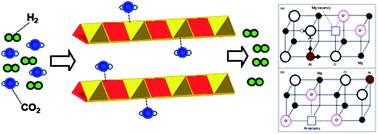Comprehensive investigation of CO2 adsorption on Mg–Al–CO3 LDH-derived mixed metal oxides
Abstract
Layered double hydroxides (LDHs) have been intensively studied for high-temperature CO2 capture. However, big differences in the CO2 capture capacity, ranging from 0.28 to 0.6 mmol g−1, have often been reported for the same Mg–Al–CO3 LDH. Furthermore, how the active Mg–O species that are responsible for CO2 adsorption are formed is still unclear. In this work, we have performed a comprehensive investigation on the CO2 adsorption characteristics of Mg–Al–CO3 LDH-derived mixed metal oxides. Based on these results we proposed the possible adsorption sites and the mechanisms for CO2 adsorption. Initially, the effects of synthesis method, Mg : Al ratio, pretreatment conditions, adsorption conditions, and thermal stability on the CO2 adsorption capacity were systematically studied. By carefully examining the structural changes during thermal treatment using X-ray diffraction and solid state NMR, we suggest that the active Mg–O species could be induced either by the substitution of Mg2+ by Al3+ in the periclase MgO lattice, or by the diffusion of Al3+ out of the octahedral brucite layers. This work not only suggests the optimal testing conditions for LDH-derived CO2 adsorbents, but also provides a clearer understanding of the CO2 adsorption sites and mechanisms on LDH-derived mixed oxides and sheds light on the synthesis and utilization of LDH-derived high-temperature CO2 adsorption materials.


 Please wait while we load your content...
Please wait while we load your content...